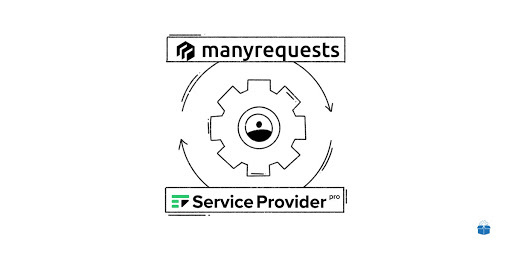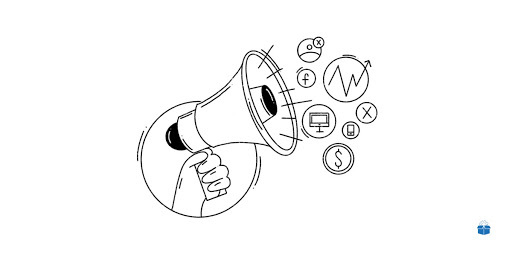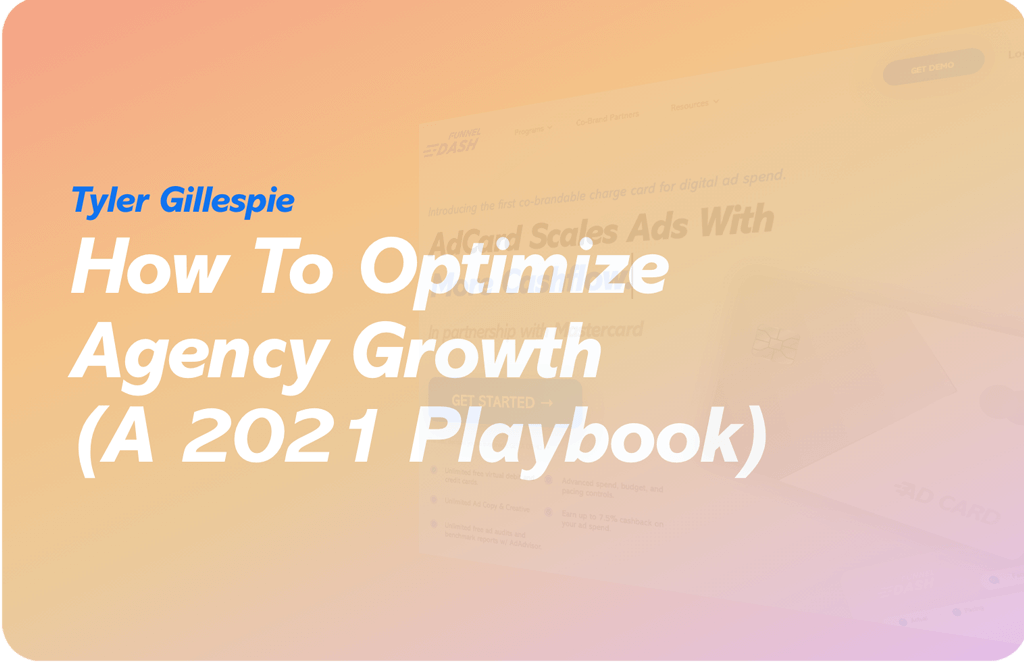Are you implementing systems to facilitate agency growth?
If you’re running into growth bottlenecks, it might be time to consider ways of optimizing your agency. For growth to materialize, you need to be firing on all cylinders.
This means taking an objective look at your current processes and identifying areas for optimization. I believe scalability should be at the forefront of every agency owner’s mind and inform their decision-making.
According to HubSpot, 43% of agencies do not have time for administrative tasks, which can result in longer working days and disengaged employees. To go ‘full throttle’ on your growth strategy, you must systematize your agency to prevent growth from affecting the delivery of your service(s) as you scale.
My name is Tyler Gillespie and I’m here to discuss a few practical ways to optimize agency growth. My insights and perspectives come from years of experience scaling and selling multiple productized services. Through the power of systemization, I have built service businesses that have been immensely profitable, scalable, and easy to exit. Much of that success has come down to systematization (creating machines).
I’m excited to share my experiences with you. When you take logical steps to optimize your agency, growth doesn’t have to be challenging. Over the years, through scaling my own service businesses, I’ve developed a playbook for optimizing growth. As we dive into practical tips and tricks, I’ll discuss my approach with you today. Without wasting any time, let’s jump in.
8 Practical Ways To Optimize Agency Growth
1 - Keep more customers

I love to ask, “How big would your agency be if you had never lost a customer?”. If you still had all of these customers, how much money would you be making right now? It’s not uncommon for service businesses to be churning a significant number of customers every month. When you apply attention to churn and recognize its importance, you can begin to address the issue.
So, how might your agency go about keeping more customers? This is a great question to start asking yourself. This is something I asked every time I brought on a new customer. Working to ensure a customer never leaves usually ends up circling back to customer experience and the general strength of your service.
It’s about creating an environment that cultivates the type of experience where a customer never wants to leave. This should drastically increase your customer lifetime value. You must start tracking the customer churn rate on a percentage basis alongside what is called “Logo churn” or the number of customers who churn each month. You should compare the number of customers you have at the beginning of the month with those you have at the end.
Once you begin tracking the churn rate, you should set some goals to work towards. The aim is to get the churn rate as low as possible. If you can achieve this, it will have a positive impact on growth and the overall value of your agency - in the event that you later choose to sell and exit. You need to focus on this number and consistently track it month after month.
If someone does need to leave, I suggest you have an exit call with them. An exit call allows you to find out more about why they have made the decision to leave. You can also look through message threads and response times to see whether the customer experience was up to scratch. Uncovering reasons why customers leave is vital to improving your service moving forward. Most believe growth is their real problem. In reality, simply it is the symptom of the real problem which is churn.
2 - Stay focused on prioritizing superior customer service

While it’s important to focus on your sales pipeline, you cannot let customer service fall off your radar. Perhaps the best way to optimize agency growth is to pour your attention into managing your existing customers and providing exceptional customer service. By ensuring you foster and maintain existing customer relationships, you will create opportunities for organic growth.
You shouldn’t underestimate the power of word-of-mouth recommendations and referrals. These are tremendously powerful growth tools. When you onboard a new customer, your mission must be to inspire retention and advocacy. This can only be accomplished through exceptional levels of customer service and support. As an agency, referrals should be your top priority.
To ensure you’re providing great customer service, maximum efficiency must be promoted across the agency. All employees need to be striving for optimal performance. It’s important to remember that it costs far more to acquire a new customer than to retain an existing one. This is why I have always focused on delivering impactful and meaningful customer experiences.
3 - Develop a scalable pricing model

It’s often easy for agencies to back themselves into a corner with unsustainable pricing models. Do your prices accurately reflect the value being provided to customers? If they don’t, it might be time for you to adjust your prices. After all, the prices should match your effort. If you’ve experienced an increase in customers, this might be the perfect time/signal to raise/audit pricing.
When you operate with a set pricing model, this will help you to allocate the right amount of resources across the agency. Combined with monthly subscription-style packages, revenue can become predictable and easier to manage. If you want to optimize your growth, agency revenue should be as predictable as you can possibly make it.
I also encourage agencies to productize their service with subscription-style packages. This can often prove to be an effective way to make revenue predictable. When you know how much revenue is coming in each month, this places you in an optimal financial position for growth. Nothing beats a steady and predictable stream of revenue - helping you to execute on growth.
Productizing can be a very versatile way to add a lot of leverage to your agency’s value ladder. I share more about this in my Productized Playbook here.
4 - Focus on systematizing repeatable processes

Processes with irregularities are not scalable. This is how normal agencies operate. Don’t be them.
It’s that simple. While individual customers may have specific needs, these should not come at the expense of your systems. When you start to overly tailor your services(b-spoke) to the needs of the individual, this can cripple growth and increase headaches. For this reason, I place the productized service model on a pedestal and appreciate the impact it has on growth (and sanity).
It’s perfectly possible to deliver an exceptional service - in a productized form - without tailoring the service to the individual needs of each customer. I’ve found that establishing expectations from the outset makes all the difference. As prospective customers establish brand awareness, you must ensure all sales materials clearly outline the productized nature of your offering.
5 - Adopt the ‘Profit First’ approach to your finances

Profit First: Transform Your Business from a Cash‑Eating Monster by Mike Michalowicz makes for a fascinating read. In this book, Mike Michalowicz outlines a counterintuitive solution to cash management. The method is simple. Each time you gain a deposit from sales, immediately set aside a percentage of that money as profit. This will make your agency permanently profitable.
Instead of Income - Expenses = Profit you now can operate within a world of…
Income - Profit = Expenses. Small shifts can move mountains.
That summarizes the system in a nutshell - it’s not quite that simple. The full book outlines all the key steps involved in making this possible. When I work with agency owners trying to optimize their growth, I walk them through this cash management solution in detail. With experience adopting the ‘Profit First’ approach, I’m well-positioned to provide advice.
Optics are vital.
6 - Leverage the right technology

ManyRequests and SPP (Service Provider Pro) are a few customer management systems. These systems make communicating with customers seamless. Customers are able to track the progress of their work inside these platforms, helping everyone stay on the same page.
ManyRequests for example can be customized with unique onboarding experiences and centralize customer communication to enhance your customer experience. (my preferred go-to option)
When it comes to customer onboarding, these systems can play a role in getting things off to a good start. As new customers enter their payment details and move through either one of these platforms, you can create questionnaires and surveys for them to answer. There are plenty of ways to collect data and optimize the customer experience for growth with these tools.
Scaling services are hard enough. Your two bottlenecks will be scaling people and technology. Having the right back end makes the technology part that much smoother. The people hurdle is a whole other discussion 🙂
7 - Build a referral system

Another thinking time question I like to ask is, “What would you do if you could only grow your agency from referrals and nothing else?” If you had to turn everything else off and you could only grow through referrals, how could you make this happen? All too often, this is a strategy being left down to chance. It’s time to stop treating referrals as a luxury and more like a necessity. These are critical to the growth of an agency.
Creating an actual referral system could be a real game-changer for your agency. You need to be intentional about referrals. When you understand the different stages of your customer journey, you can map out where it will be most appropriate to ask for referrals. Set yourself a target of asking for 1 referral each day for your agency from your customer base and network.
You can leverage your customer base and broader network to ask for 1 referral each day. I would recommend building this into your schedule so that it becomes a repeatable habit. When you do this, the results will start to compound over time. If each customer introduced you to 3 people in their network, how many sales conversations could you have in the span of 60-90 days?
8 - Avoid common ad spend mistakes

A. Targeting segments that are too wide
While it might seem logical to start broad, attempting to reach an overly broad audience might be an indication that you do not fully understand your target customer’s buying behavior. It’s vital to establish buying personas before you launch paid advertising campaigns. This is research that simply cannot be overlooked. Without it, you’re throwing random darts aimlessly.
Depending on the marketing channel, you should be able to see which demographics are performing better than others. This will help you to question why you’re seeing certain results and enable you to improve the ROI for your campaign. Help your target audience find you faster by optimizing your audience segments in a clear and concise way.
B. Failing to utilize the “exclude” option
The easiest way to drain your ad budget is by failing to optimize your campaign targeting and going too broad. Even though paid advertising platforms will try to automatically optimize your campaign targeting, this can often prove to be far from efficient. To squeeze as much value from your ad budget as possible, you should be using the “exclude” option on various platforms.
This allows you to exclude those in specific demographics with particular interests from seeing your advertising campaigns. As you will know, reaching certain types of audiences is more expensive than reaching others. When you start excluding audiences that you know will drain your advertising budget, the prospects for your campaign will be greatly improved.
C. Treating desktop and mobile equally
When you’re running digital advertising campaigns, you should be thinking about the types of devices your advertisements will appear on. It’s easier to segment traffic into various categories for mobile devices. For instance, through the use of exclusion filters in campaigns, you are able to completely exclude and eliminate traffic from older mobile devices.
Alongside this, another important feature of mobile devices is location tracking. To understand where your target audience is allocating most of their time, you can target mobile traffic. I know some agency owners that choose to raise bids for certain mobile devices while filtering out mobile tablets to set their campaigns in a strong position going forward.
D. Disregarding data and making false assumptions
Marketing data is essential to the success of any campaign. If your decision-making is not backed by data, you’re often just guessing. While this may work on some occasions, it is far from scalable. If you want to optimize agency growth, you must be making data-backed decisions and taking ad spend bets that provide significant upside potential.
Scalable paid advertising campaigns are not built on assumptions. You should be utilizing a range of data tracking tools to prevent your campaigns from failing prematurely. Data is your friend and should be referred to throughout any campaign. If you’re willing to throw advertising dollars at campaigns, collecting and analyzing data is the responsible thing to do.
E. Capping your advertising budget
If a campaign is working well, what’s stopping you from scaling it up? The answer to this question is nearly always a lack of capital. Capping your advertising spend is stifling your growth and preventing your campaigns from reaching their true potential. If you’ve cracked a winning conversion formula, you should be able to push this to the limit with an increased spend.
Unfortunately, this isn’t always possible. A lack of capital is slowing down the growth of your agency. Even with a perfectly productized setup and exceedingly high conversion rates, it isn’t always realistic to allocate unlimited capital to your advertising spend. When I was introduced to FunnelDash’s AdCard, this completely changed the game for me.
I’ve been particularly inspired by FunnelDash’s vision for a future where business growth is never slowed down by a lack of capital. If you’re running an incredible advertising campaign with jaw-dropping conversion rates, why not scale this up with a credit card? AdCard is the highest cashback card for digital advertising spends I’ve come across.
Are you looking to scale your digital service business?
I’m actively supporting a small group of business owners, including several agency founders, to optimize their growth potential.
If you’ve been dreaming about turning six-figure years into six-figure months, check out some of the free resources I have around productizing your service business here. I hope you’ve enjoyed a taste of my insights with this article. Keep building!
Tyler


